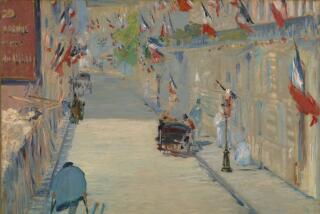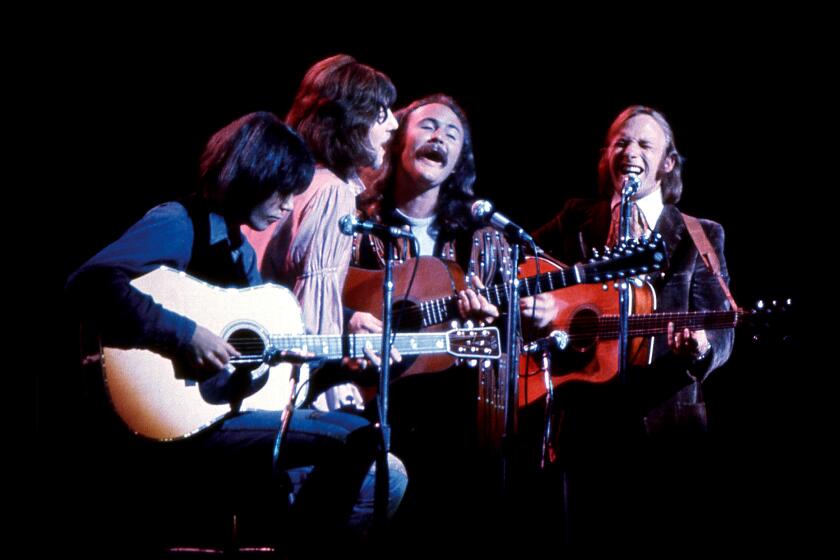IMAGINED BATTLES: Reflections of War in European Art.<i> By Peter Paret</i> .<i> University of North Carolina: 152 pp., $34.95</i>
- Share via
In his famous 1770 painting, “The Death of General Wolfe,” Benjamin West boldly imagined the dying general and the soldiers around him in conventional dress. The robes and togas of antiquity that had marked other battlefield scenes were conspicuously absent. West, eager to commemorate this critical scene of British history (Wolfe’s seizure of Quebec hugely enlarged the British empire), dared to imagine this moment in contemporary military dress without departing altogether from the classical criteria.
Yet for Peter Paret in “Imagined Battles,” what makes this striking and controversial painting most significant is not the clothing of its protagonists but the paradoxical lack of realism accompanying the moment. Paret’s driving interest is to show how war, a constant feature of European history, was evaluated and interpreted by the intellectual elite. Why do so many of those works strike us, in our war-sated age, as missing the point or getting it wrong? What attitudes toward war may we infer from their general focus on glamour and glory? What exactly was going on in the minds behind the brushes?
Paret, a professor emeritus at Princeton who was already established as a cultural historian before he became renowned in the war history field, answers these questions in the way you would expect: with a sober and serious history lesson.
Take the case of West’s Pieta-like rendering of Wolfe’s battlefield death. Paret explains that “West did not seek reportorial accuracy. He interpreted the death of the British general as a human tragedy subsumed in the larger national drama of sacrifice and victory, a drama through which ran the subsidiary theme of the country’s leaders fulfilling their duty. The modern uniforms and weapons carried the metaphor into present reality.” About 30 years later, West performed the same elevating and what he called “animating” service for Lord Admiral Nelson, remarking that the superhero should not “be represented dying in the gloomy hold of a ship, like a sick man in a prison hole.” Yet that is the way Nelson did die, and how certain of West’s less prestigious contemporaries, their minds moving toward our modern sensibility, actually preferred to represent the event. West knew about the blood, the pain and the stench; he just didn’t think it necessary or proper to emphasize it.
More than a century earlier, Peter Paul Rubens, one of thegrand masters whom West revered, was commissioned by the grand duke of Tuscany to do a painting on the horrors-of-war theme. Rubens was pleased to oblige, not least because he considered war horrid and lamentable (“pestilence and hunger, those inseparable partners of war . . . war, which devastates and destroys everything,” wrote Rubens to one of his patrons in Florence), but like any sensible person of his time, Rubens couldn’t imagine a world without war. The war victims he positively puts before us are only vague allegorical figures, not real people: Harmony with her lute broken; an Architect, symbol of the constructive achievements of peace, whom Mars’ violence has knocked to the ground; and a weeping, black-clad Ancient representing “unfortunate Europe, victim for so many years now of plunder, outrage and misery.” Paret cites Rubens’ explanation at some length to understand how the picture was to be read and points out the painting’s one “direct reference to war” (a bit of battle seen from afar) and Paret sums up thus: “Despite the dramatic scene, Rubens here treats war from a distance, as it might appear in the cabinet of the prince or the study of the philosopher, where suffering and destruction are certainly to be understood to be parts of war, but the human costs largely disappear in abstractions, which in the painting are given superhuman form.” (Though Venus, one may happily note, is quite a superwoman too.)
The flaring lights, the stormy skies, the hectic activity of terrified or terrifying figures (whose meanings would have been familiar to Rubens’ classically educated public) convey a denser message than the full-frontal images of human suffering (for instance, the photograph of a running napalmed girl during the Vietnam War) that have attained iconic status for us 3 1/2 centuries later. Times and cultures change. While Paret delights in pointing out how much we may miss if we don’t learn how to read such unfamiliar modes of commentary on war as Rubens’ works, he is no less interested in marking the steps by which artists have developed more modern representations with an emphasis on the common soldier and the civilian.
The print-maker Jacques Callot is a key figure here. A resident of the much-marched-over province of Lorraine, he published in Paris in 1633 a set of 17 stylish etchings under the title “Les Miseres et les Malheurs de la Guerre.” The more violent and painful of them will be familiar to many readers because they have been used ad nauseam to illustrate history and antiwar books, but Paret characteristically argues that there is more to them and to Callot’s purpose than first meets the eye. If we scrutinize the whole set, we see that the common soldier’s life is not just an endless round of enjoyable rapine, looting and destruction. Some of the prints show simply, even dispassionately, how the new-style armies of Callot’s time were raised, managed and disciplined. One of the prints shows discipline enforced by a mass hanging of delinquents: deserters, perhaps, or unlicensed looters. One of the most savage shows how peasants, ambushing a numerically superior force of soldiers, might take their revenge.
Paret’s point is that Callot’s depictions were as much scientific as humanitarian and that we misread him if we let our assumptions override his. His “realism,” moreover, had its contrived baroque aspects; he was not as artistically distanced from Rubens as one might suppose.
The common soldier and the civilian both began to come into their own during the Revolutionary and Napoleonic wars. Mars and Venus have completely disappeared from paintings by now; the Great Commander is still there (and how! one might add, noting the divinization of Napoleon), but around him appear, in ever-swelling numbers, the common soldiery (doubly interesting now that its duty is not just to obey its commander but equally to serve its country). The era of nationalism, democracy and national military service in the 19th century necessarily set new priorities for its war artists. Paret perhaps appears at his most eye-opening and pleasure-giving in the many pages he devotes to two of that century’s most accomplished and famous representers of their respective nations’ military histories: the Frenchman Ernest Meissonier and the German Adolph Menzel, both remarkable for the meticulous accuracy of their technical detail and for the breadth and decency of their human sympathies and their emotional vocabularies.
The common soldier story is brought into the 20th century with Ferdinand Hodler and Otto Dix. The Expressionist Hodler’s experience in Zurich rather recalls West’s experience in George III’s London: a controversy about the appropriateness of an innovative artist’s idea for representing an episode of national glory. Paret’s use of Hodler’s “Retreat From Marignano” on the dust-jacket, and reproduced more than once within, suggests his special wish to persuade us that even the most superficial, unlikely-looking depiction of historic fighting men (to a British eye, Hodler’s heroes look like Continental cousins of the seriocomic Yeomen of the Guard), once its context and principles are understood, can sound the deepest notes. “Style and subject,” Paret remarks, “combined into a seamless image” of a great national event, all distractions of detail submerged in its monumental stylization.
With Dix, whose supreme mastery Paret rightly emphasizes, we conclude with the “horrors of war,” an area that was explored to great extent by Goya, distinguished earlier for his “evenhanded moral outrage and analysis of the structure and form of violence.” But for Dix, the problem posed by the industrialization and mass mobilization of war is immense, and this is where Paret bleakly closes his account: “Beyond metaphors and allegories and the expansion and distortion of the literal by such artists as Dix and Max Beckmann, the only strong alternative to artists in depicting war in the twentieth century appears to have been a greater degree of formal abstraction . . . [culminating in] Nevinson’s ‘Explosion of 1916,’ in which nothing is shown but a brown field, the sky, and where they meet the burst of a shell.”
One of the effects of a good book is that it leaves you longing for more and thinking of how its lessons might be applied in other fields. I am left thinking especially about maritime warfare, scarcely noticed in “Imagined Battles,” and about Eastern Europe and Russia. Another effect of a good book can be some sort of gratitude. Peter Paret’s critical judgments will not be to everyone’s liking, but he is surely to be thanked for rescuing the “images of war” genre from its generally mindless status and for instructing us on how to incorporate the representation of war into our most serious reflections on that dreadful, fascinating and seemingly inescapable aspect of our human condition.
More to Read
The biggest entertainment stories
Get our big stories about Hollywood, film, television, music, arts, culture and more right in your inbox as soon as they publish.
You may occasionally receive promotional content from the Los Angeles Times.










